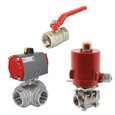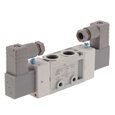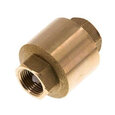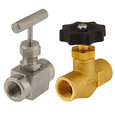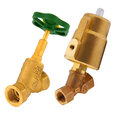What Type Of Valves Are Piggable
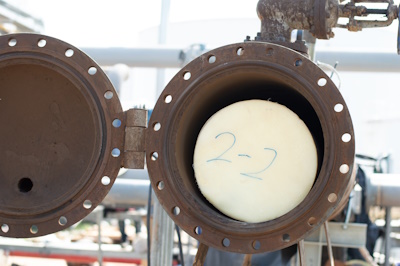
Figure 1: Installation of foam pig for pipe cleaning
Pigging valves are specially designed valves that allow cleaning and inspection tools called 'pigs (pipeline inspection gauges)' to pass through them smoothly during pipeline operations. These valves have a clear, straight-through path inside them and are essential in pipelines that need regular cleaning and inspection to keep working safely. However, not all valves are suitable for pigging operations. The choice of the right piggable valve is especially important in pipelines that carry different types of products or dangerous materials, as these pipelines need frequent checks to prevent problems and maintain efficient operation. This article explores the types of valves that are piggable, providing insights on their design and working in industrial settings.
View our online selection of valves!
Understanding pigging valves
A pig is a device (mechanical, foam, or smart device) that is sent through the pipeline to perform various tasks such as cleaning, inspecting, and maintaining the pipeline's integrity. Piggable systems improve efficiency and reduce costs in process lines handling multiple products. They allow complete removal of line contents after each transfer, either to the receipt point (the destination where the product is delivered) or back to the source tank (the origin where the product is stored), minimizing product waste. This process recovers valuable products and enables quick product changeovers, reducing downtime and cleaning needs. The ability to swiftly switch between products without extensive manual cleaning enhances operational flexibility and productivity. Piggable systems are valuable in industries like food and beverage, pharmaceuticals, and chemicals, where efficient product handling and minimal waste are critical.
What is a piggable valve
A piggable valve is a valve that allows a pipeline pig to pass through it without causing an obstruction. This means that the valve must have a bore that is the same size as the pipeline it is attached to, and it must be free of any internal obstructions when fully opened. The most common types of piggable valves are full bore ball valves and gate valves with full opening. However, other valve types can also be piggable under certain conditions (discussed later).

Figure 2: Pig receiver in oil and gas industry
Ball valves
Ball valves have a spherical disc that controls the flow of fluid. When the valve is open, the ball's hole aligns with the pipeline, allowing the pig to pass through.
- Full bore:Full bore ball valves are designed with a spherical disc that has a hole through the center. When the valve is in the open position, the hole aligns with the pipeline, creating a continuous, unobstructed path for the pig.
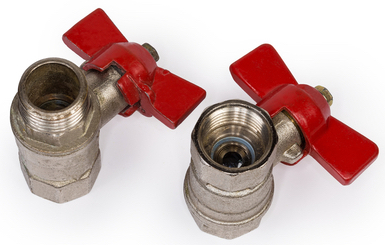
Figure 3: Full port (left) and reduced port (right) ball valves
- Trunnion:Trunnion mounted ball valves, also known as shut-off pigging valves, are specifically designed for pigging operations. These valves have a trunnion, or mechanical anchoring system, that supports the ball and reduces the torque required to operate the valve. This design ensures that the valve can handle high-pressure applications and provides a clear path for the pig. Trunnion-mounted ball valves, in particular, are highly piggable due to their robust design and ability to handle high-pressure applications.
Gate valves
Through conduit or slab gate valves have a gate that moves perpendicular to the flow of the fluid. When fully open, gate valves provide a clear, unobstructed path for the pig. They are commonly used in pipelines where pigging is a routine maintenance activity. Gate valves can be used in a wide range of applications, from low-pressure to high-pressure systems. Also, they are designed to handle various types of media, including corrosive and abrasive fluids.
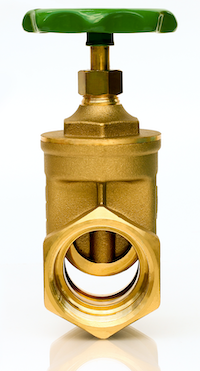
Figure 4: Gate valve
Check valves
While not all check valves are piggable, some designs can accommodate pigging operations. Check valves allow fluid to flow in one direction and prevent backflow. For pigging, the check valve must have a through conduit design to ensure that the pig can pass through without obstruction. For example, swing check valves have a disc that swings open to allow fluid flow and closes to prevent backflow. When fully open, the disc provides a clear path for the pig.

Figure 5: Wafer swing check valve
Non-piggable valves
Valves that do not have a through conduit design are generally not piggable.
- Reduced bore valve: Reduced bore ball valves are one of the most common types of non-piggable valves. These valves have a smaller internal diameter than the connecting pipeline, creating a restriction that prevents pig passage. They are particularly common in older installations where space or weight constraints were significant factors in the design.
- Butterfly valve:Butterfly valves, commonly used in low-pressure applications, feature a central disc or flap mechanism. The presence of the shaft and disc assembly creates an obstruction that prevents standard pigging operations. Similarly, gate valves with reduced bore contain wedge-type gates with smaller throughput, where guide channels and seats create restrictions that impede pig movement.

Figure 6: Butterfly valve
- Multi-port valves and complex installations: Multi-port valves present another significant category of non-piggable components. These valves feature complex internal geometry with multiple flow paths, such as three-way and four-way valves. Their intricate internal structure creates obstacles that make conventional pig passage impossible. Complex valve assemblies represent another challenge for pigging operations. These installations often involve multiple valves in series with different bore sizes, check valve combinations, and varying internal geometries that make conventional pigging impossible.
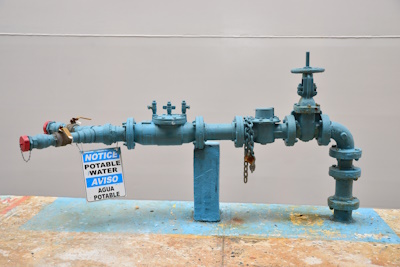
Figure 7: Complex valve configurations in series and varying internal geometries make conventional pigging difficult
Practical considerations for pigging in valves
Advancements in pigging types have led to the development of smart pigs, which can navigate through non-piggable valves. Smart pigs are equipped with sensors and data collection capabilities, allowing them to adapt to the pipeline's geometry and pass through traditionally non-piggable valves. Temporary solutions can be employed to improve the inspection process. These include the installation of temporary bypass systems, the use of multi-diameter pigs for restricted bores, and in some cases, complete valve removal for offline inspection. While these methods can be effective, they often require significant planning and may impact operational continuity.
When selecting piggable valves, it is crucial to consider the specific requirements of the pigging process and the type of pig being used. Different pigs have varying levels of robustness and adaptability, which can affect their compatibility with certain valve designs. For example:
- Plastic skin-clad pigs have a plastic skin that can be damaged by protruding edges in valves or abrupt bends in the pipeline. They are typically used for light cleaning tasks, such as removing organic growth in drinking-water pipes.
- Robust pigs are designed for more demanding applications; these pigs can handle rough cleaning tasks, such as removing burnt-on process residues in heat exchangers.
It is essential to ensure that the pig can pass through the valve without damaging the valve's trim or internal components. Conversely, the pig should not be damaged by the valve.
FAQs
What is pigging in a valve?
Pigging refers to the practice of using a cleaning or inspection device (called a "pig") that is sent through a pipeline system, and the components like valves connected to it.
Are ball valves piggable?
Yes, ball valves can be piggable if they are full-bore, meaning the internal diameter of the valve is the same as the pipeline, allowing pigs to pass through without obstruction.





